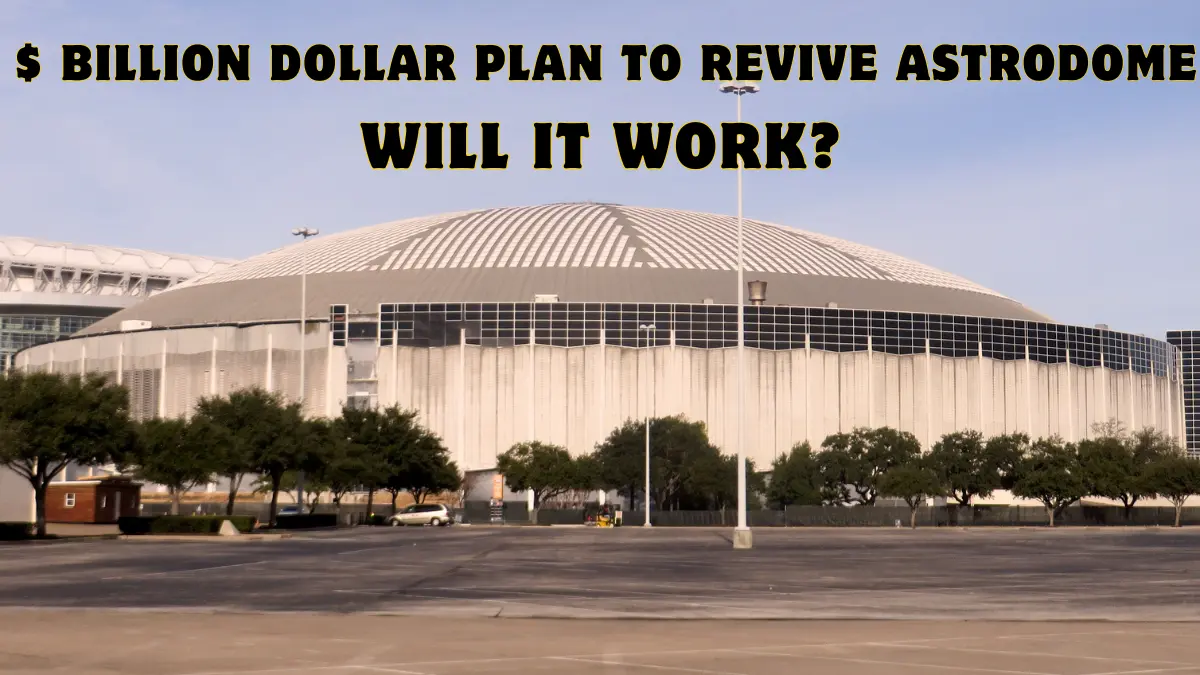After more than a decade of stalled discussions and competing proposals, Houston is preparing to make a final decision about the fate of the Astrodome – one of the city’s most iconic landmarks.
Once celebrated as the “Eighth Wonder of the World” for its engineering feats, the structure now stands empty and underutilized, while continuing to incur millions in annual maintenance costs.
City officials, preservationists, and developers are weighing three primary redevelopment strategies, including a $1 billion transformation plan, a limited-use rehab, and a proposal to convert it into an academic innovation hub.
A Monumental Engineering Feat, Now Largely Dormant
The Astrodome’s story began in 1952 with Judge Roy Hofheinz’s vision to bring Major League Baseball to Houston, but indoors. Officially opening in 1965, the Astrodome was the world’s first fully enclosed, climate-controlled stadium.
The 712-foot-wide lamella truss roof created a massive column-free interior, capable of accommodating 66,000 spectators across six tiers. Designed to host both baseball and football, the stadium pioneered technologies like a 6,000-ton climate control system and AstroTurf, the first synthetic playing surface used in a major sports venue.
Despite its early success and versatility, hosting the Houston Astros, Oilers, Rockets, the Houston Livestock Show and Rodeo, and even emergency shelters, the Astrodome ceased hosting major events by 2009. The adjacent NRG Stadium, with modern amenities and lower operating costs, became the city’s new event epicenter.
Preserved, But At a Cost
Although no longer operational, the Astrodome remains structurally sound. A $105 million roof remediation completed in 2018 ensured its lamella truss system remains stable and corrosion-free. However, without climate-controlled use, interior fixtures and finishes have deteriorated significantly. Today, Harris County spends approximately $2.3 million annually on utilities, security, and structural inspections, despite the structure generating no revenue.
Its designation as a Texas State Antiquities Landmark in 2018 offers some protection against demolition, but not guaranteed funding for restoration. Demolishing the dome would require state approval and an estimated $30–$40 million, only possible if all reuse options are deemed unviable.
Three Competing Visions for the Astrodome
1. Vision Astrodome – $1 Billion Full Redevelopment
The most ambitious proposal, led by the Astrodome Conservancy and design firm Gensler, calls for a full interior transformation while preserving the historic exterior. Key features include:
- A 10,000-seat multipurpose arena for sports and community events
- 200,000 sq ft of mixed-use space including retail, offices, and restaurants
- A 150-room boutique hotel
- A skywalk boulevard, inspired by New York’s High Line, integrates solar panels and green spaces
Funding would be sourced from $200 million in preservation tax credits, $400 million in private investment and sponsorships, and $400 million from philanthropic and public sources. Construction could begin in 2028 and finish by 2031.
2. Limited-Use Rehab – $200 Million Intermediate Option
This plan proposes moderate renovations to enable occasional large-scale events like rodeos, motorsport shows, and trade expos. It would include:
- Restoration of seating risers
- Flooring replacements
- Installation of modular HVAC and lighting systems
Though revenue projections are modest at $5 million annually, this option requires significantly lower capital and fewer preservation approvals.
3. Innovation Campus – $150 Million Academic Conversion
This proposal envisions a collaboration with institutions like the University of Houston and Texas A&M to convert the dome into:
- Engineering labs and material testing centers
- An urban sustainability incubator
- Corporate R&D spaces
Funded via academic leases, grants, and research partnerships, this plan prioritizes educational value and long-term societal impact over short-term commercial returns.
Public Sentiment and Policy Constraints
Public surveys indicate strong support, approximately 95%, for reuse over demolition. However, fewer than half of the respondents are in favor of allocating significant taxpayer funding beyond existing preservation grants. Harris County officials have emphasized that any public funding must align with the operational needs of NRG Park and broader urban development goals.
Demolition, while technically feasible, remains a controversial and unlikely option given the Astrodome’s protected status. However, if redevelopment efforts stall or funding cannot be secured, it may resurface as a final resort.
A Legacy at the Crossroads
As one of the most iconic engineering achievements of the 20th century, the Astrodome continues to symbolize innovation, ambition, and the challenges of adaptive reuse. The decisions made in the coming years will determine whether this once-revolutionary structure is reborn for a new era or relegated to memory.
Also Read –
Will Trump’s Tariffs Make Everything More Expensive In The U.S?
